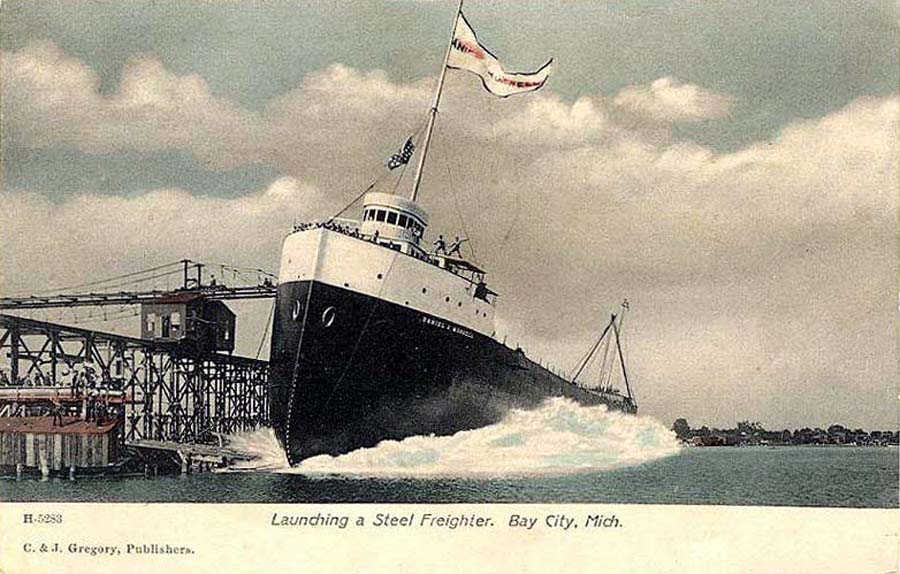
22 August 1906
Unknown Author
Public Domain via Wikimedia Commons
The sinking of the SS Daniel J. Morrell in 1966 during a fierce November storm on Lake Huron is often compared to the Edmund Fitzgerald, but less remembered. It broke up during the storm and only person out of29 crewmen survived.
The ship was launched in 1906 and at 603 feet long was considered one of the largest bulk carriers on the lakes at the time. Her sister ship, Edward Y. Townsend, was of the same length and both worked the Great Lakes transporting bulk cargo. By 1966, they were no longer the largest but were still making bulk freight deliveries. Both the Morrell and Townsend were making their last run of the season on 29 Nov 1966 when disaster struck. The infamous “Gales of November” were roaring on Lake Huron with wind speeds that topped 70 mph (110 km/h). Seas were high with swells that topped the ship. The Townsend decided to seek shelter in the St. Clair River while the Morrell continued its journey to Thunder Bay for shelter.
At 2 am, noises that sounded like a loud banging drove the crew to the deck. They could see the ship was in dire condition, so many jumped into the frigid waters to die. At 2:15 am the ship broke in two. The crew still on the bow got into a lifeboat mostly wearing light clothing since they had come up from below. Some thought another ship was coming, but the aft was still moving as the propellers were turning. It went about five miles before it sank. Since they had no chance to send any messages, there was no SOS sent from the ship. The surviving crewmen fired off flares to get attention to no avail.
The Morrell was deemed overdue the next day at 12:15 pm at Taconite Harbor, Minnesota. The Coast Guard began looking and at around 4:00 pm located a lifeboat with one survivor in it. The other three had perished from the cold. 26-year-old Watchman Dennis Hale was the lone survivor. He was wearing boxer shorts, a life jacket, and a pea coat. He would need many surgeries to deal with the injuries he suffered that night. Most of the bodies of the rest of the crew were found, though two were never located. Hale’s testimony would prove important to the investigation that followed.
Hale would testify that the Morrell was well known as leaky. He reported to Captain Arthur I. Crawley, who responded they did not have time to fix since they were not in port long enough. The Coast Guard inspected the Townsend and found a large crack in her deck caused by the storm. She was immediately taken out service and never sailed again. Ironically, she would sink on her way to be scrapped off Newfoundland during a storm. She was being towed, so no lives were lost when she sank.
The investigation showed that the steel used in her construction had too much sulfur in it resulting it becoming brittle in cold weather. And the ship finally met a storm on a very cold night that finally did her in. Brittle steel has been identified as to one of the reasons the Titanic sank so quickly. Hale would never sail on the Great Lakes again after surviving the sinking. He spoke rarely about his ordeal but did write a book about it.
Sources:
Bingham, Emily (27 April 2018)
Remembering the Daniel J. Morrell, a 1966 Great Lakes shipwreck lost to the gales of November
Michigan Live. Retrieved on 17 Nov 2022.
Werner, Gene (27 Nov 2016)
50 years after shipwreck took 28 lives, the lone survivor’s tale
The Buffalo News. Retrieved on 17 Nov 2022
SS Daniel J. Morrell
U.S. Data Repository. Retrieved 17 Nov 2022
SS Daniel J. Morrell
Wikipedia. Retrieved 17 Nov 2022
NPR (6 Nov 2013)
Adrift In Frigid Water, Not Caring ‘If You Live Or Die’
NPR. Retrieved 17 Nov 2022
